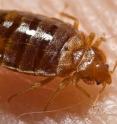Bed bugs have developed resistance to neonicotinoids
A new study published in the Journal of Medical Entomology is the first to report that bed bugs have developed resistance to a class of insecticides known as neonicotinoids, or neonics, the shortened name. Neonics are the most widely used group of insecticides today, and several products have been developed for bed bug control over the past few years that combine neonics with pyrethroids, another class of insecticide. Dr. Alvaro Romero from New Mexico State University and Dr. Troy Anderson from Virginia Tech collected bed bugs from human dwellings in Cincinnati and Michigan and exposed them to four different neonics: acetamiprid, dinotefuran, imidacloprid, and thiamethoxam. They also applied these neonics to a bed bug colony kept by Dr. Harold Harlan for more than 30 years without any insecticide exposure, and to a pyrethroid-resistant population from Jersey City that had not been exposed to neonics since they were collected in New Jersey in 2008.
Unsurprisingly, the Harlan bed bugs died even when exposed to very small amounts of the neonics. The Jersey City bed bugs fared slightly better, showing moderate resistance to acetamiprid and dinotefuran, but not to imidacloprid or thiamethoxam.
The authors believe that the detection of neonicotinoid resistance in the Jersey City bed bugs, which were collected before the widespread use of neonics, could be due to pre-existing resistance mechanisms. When exposed to insecticides, bed bugs produce "detoxifying enzymes" to counter them, and the researchers found that the levels of detoxifying enzymes in the Jersey City bed bugs were higher than those of the susceptible Harlan population.
"Elevated levels of detoxifying enzymes induced by other classes of insecticides might affect the performance of newer insecticides," said Dr. Romero.
The bed bugs from Michigan and Cincinnati, which were collected after combinations of pyrethroids and neonicotinoids were introduced to the U.S. market, had even higher levels of resistance to neonics.
It only took 0.3 nanograms of acetamiprid to kill 50 percent of the non-resistant bed bugs from Dr. Harlan's lab, but it took more than 10,000 nanograms to kill 50 percent of the Michigan and Cincinnati bed bugs. Just 2.3 nanograms of imidacloprid was enough to kill 50 percent of the Harlan bed bugs, but it took 1,064 and 365 nanograms to kill the Michigan and Cincinnati bed bugs, respectively. The numbers were similar for dinotefuran and thiamethoxam.
Compared to the Harlan control group, the Michigan bed bugs were 462 times more resistant to imidacloprid, 198 times more resistant to dinotefuran, 546 times more resistant to thiamethoxam, and 33,333 times more resistant to acetamiprid.
The Cincinnati bed bugs were 163 times more resistant to imidacloprid, 226 times more resistant to thiamethoxam, 358 times more resistant to dinotefuran, and 33,333 times more resistant to acetamiprid.
"Companies need to be vigilant for hints of declining performance of products that contain neonicotinoids," Dr. Romero said. "For example, bed bugs persisting on previously treated surfaces might be an indication of resistance. In these cases, laboratory confirmation of resistance is advised, and if resistance is detected, products with different modes of action need to be considered, along with the use of non-chemical methods."
Source: Entomological Society of America
Articles on the same topic
- Bedbugs develop resistance to widely used chemical treatments, rendering them ineffectiveThu, 28 Jan 2016, 15:49:40 UTC
Other sources
- Bed bugs develop resistance to widely used pesticidesfrom UPIThu, 28 Jan 2016, 15:32:35 UTC
- Bed bugs have developed resistance to neonicotinoidsfrom Science BlogThu, 28 Jan 2016, 14:40:56 UTC
- Bed bugs resist widely used chemicalsfrom BBC News: Science & NatureThu, 28 Jan 2016, 14:09:27 UTC
- Bedbugs develop resistance to widely used chemical treatments, rendering them ineffectivefrom PhysorgThu, 28 Jan 2016, 14:04:15 UTC
